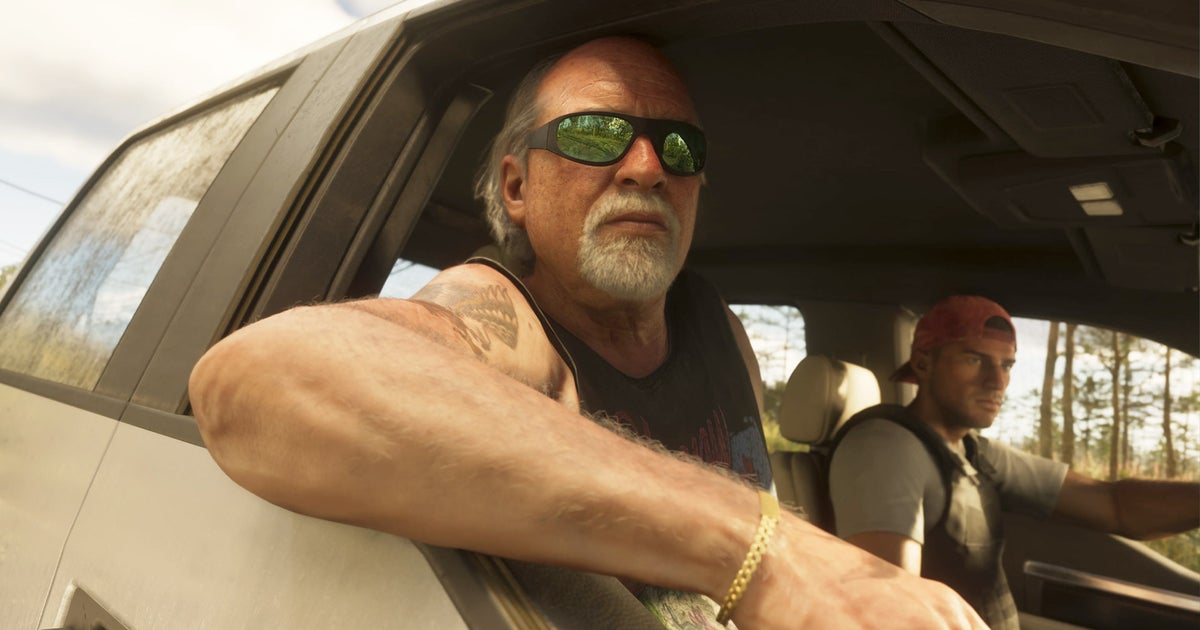Grand Theft Auto 6 may not be coming out until May 2026, but Rockstar salved our disappointment with the release of Trailer 2, an action-packed mixture of cutscenes and gameplay. Despite being less than three minutes long, the trailer is packed with a huge amount of clues to the game’s current technical make-up, including its resolution and frame-rate figures, as well as a look at some of the graphical techniques that will define its overall look.
First, the basics: the trailer was released in 4K at 30fps with black bars – producing a rather odd 20:9 aspect ratio – with text at the end of the trailer confirming it was recorded on a base PS5 instead of the more powerful PS5 Pro. Internal resolution counts come out at 1440p, or 2560×1152 to be exact – that’s 80 percent of 1440p on the vertical axis. The trailer seems to be using a spatial upscaler, something like AMD’s first-generation FSR, with that characteristic curved look present in fine detail like distant text. This means image quality is a little soft, but makes it more believable that the game is actually running on a base PS5, bearing in mind the relatively realistic details and graphical effects elsewhere.
Despite ostensibly including “gameplay” segments, it’s clear that the majority of the trailer shows cutscenes, with only a handful of shots that resemble typical gameplay shots from earlier entries in the series. As such, Rockstar is free to add extra light sources – as you would in a film set – to ensure that characters, objects and environments all look their best. (You can see instances where character faces are lit from the front when the sun is behind them, for example.) The material work here is exceptional, but without seeing proper gameplay it’s hard to imagine that the game will look quite as realistic and detailed during moment-to-moment gameplay as it does during the scenes that play out in Trailer 2.
While the entire trailer is exceptional in terms of its detail, it’s clear that the ray-traced global illumination (RTGI) is responsible for a lot of the game’s realistic look, which applies to both sunny Floridian scenes and perhaps more eye-catching scenes in low light.
For example, when the protagonists are driving past the police cars 45 seconds into the trailer, there’s a realistic evening glow reflecting off the walls next to the squad cars, while the lights from each car also bounce into the scene to colour their surroundings. It’s an excellent example of the fidelity of the indirect diffuse lighting that gives GTA 6 such a true-to-life look – even though, again, we might not see that level of per-pixel detail reflected in free-form gameplay.
The level of temporal stability in the lighting is also impressive, with even high-end Unreal Engine 5 titles on using software Lumen exhibiting visual discontinuities, flicker or crawling artefacts, especially on consoles. There’s none of that here, which is an impressive achievement if it translates into the full game.
The game also features real-time ray-traced reflections, which are evident across both rough and smooth opaque surfaces. As with many other console titles to feature RT reflections, GTA 6 seems to use a hybrid approach, with the RT combined with screen-space reflections that add in extra detail to a scene at the cost of potential artefacts. Where the game seems more next-level is in its handling of reflections on partially transparent surfaces such as glass, plastic and water, which is something we didn’t see in the first GTA 6 trailer when it was released over 500 days ago.
Trailer 2 shows off these transparent reflections quite prominently, with reflections visible in glass bottles, glass windows and auto glass. Perhaps the best example comes 28 seconds into the trailer, where protagonist Jason is driving with his car window rolled nearly all the way down. The segment of the window that remains shows off a reflection of the beach weather outside, with visible clouds and sky; other windows in the car have their own reflections; both visible mirrors show street-level detail; the dashboard is reflected on the windscreen; the view ahead appears in Jason’s sunglasses; even his watch shows off a reflection. This scene would only be possible with real-time ray tracing, and it looks exceptional, without some of the typical optimisations we see on console games where some objects or textures aren’t shown in the reflection.
Beyond this shot, it’s wild to see how well the glass beer bottles are rendered in scenes at 42 seconds and two minutes and nine seconds, with bubbles rising to the surface, the liquid sloshing around and the ambient lighting of the environment producing a realistic glow as it travels through the glass and lights the beer within. Rockstar is known for realistically simulating things that most developers would approximate – think about horse musculature and digestion in Red Dead Redemption 2 – and this seems like a good example of the level of fidelity they’ll go despite the size of the game world.
While the game features RTGI and ray-traced reflections, it looks like shadows are handled with a more traditional shadow map technique. For example, at 1:42, you can see that the shadows for the drawer handles in the background are disconnected from the hadnles themselves, a common issue. There is also some aliasing visible in shadows, though shadows are generally well-filtered.
Regardless, choosing to use this technique is a sensible performance optimisation, given how much RT is used elsewhere, and the results are rarely distracting. In fact, the shadows on characters tend to be fairly detailed, with variable penumbra effects visible elsewhere, and there are only a handful of scenes where the limitations of the technique are visible upon close inspection.
Another place where Rockstar are pushing the boat out is in terms of character and hair rendering. A monumental quality leap here is evident in GTA 6, with higher-fidelity characters and particularly more dynamic hair rendering. One minute and 11 seconds into the trailer is a great example, where Lucia rolls on the bed and her hair whips around realistically; there’s another twirl 25 seconds later that also looks great. This suggests a strand-based hair system is in play rather than a more traditional card-based system, and allows for a much greater diversity of hair types to look natural, especially curlier styles, in motion.
As with the other systems we’ve discussed, there are hints towards some sensible optimisations in play when it comes to hair rendering. For example, the shot of Jason at 1:38 seems to show his hair being rendered at a lower resolution than the rest of his features. That makes sense to ensure that the performance cost of the higher-fidelity hair isn’t too high, but could lead to a softer or more aliased look in some scenarios. It’ll be interesting to see if there are further optimisations, ie less realistic fall-backs for gameplay or when multiple characters are on-screen.
The specular response of the skin rendering here is excellent too, with the sweat visible on certain characters being particularly noteworthy – from the sweat beading on the brow of a hostage to the wet back and arms of Jason as he walks into his beach house. We also noted the secondary animation found in baggier clothing, giving it a more realistic look as characters walk or move their arms. The arm hair on display here is also next-level, with realistic-looking fuzz that could look exceptional if the game features an (optional) first-person perspective.
With the huge amount of fidelity evident in the new trailer, it’s worth revisiting whether or not Grand Theft Auto 6 will be playable in a 60fps mode on console – the source of some debate following the game’s initial reveal. Our initial view was that 60fps seems to be off the table, and Trailer 2 doesn’t really disabuse us of that notion.
You could certainly imagine a world where Rockstar adds in a 60fps mode that still runs at 30fps during cutscenes to keep fidelity high, but it’s hard to imagine a 60fps mode that also includes the RTGI and RT reflections that lends the game world its realistic look. At that point, the game world would look so dramatically different – and require so much additional work to recreate the lighting and reflections using rasterised techniques – that it scarcely seems believable. Beyond this, a lower internal resolution would be required, which feels like another unacceptable cut in fidelity given the FSR-like upscaling present here. Add in the open world, and the extra CPU demands that requires, and 60fps feels like a step too far for current-gen consoles.
That also likely means that the game is “too big” for Switch 2, at least based on what we know about the T239 chip the Nintendo handheld is based around. Even running at 30fps and with a lower internal resolution, the level of fidelity and CPU demand here seems impossible to port to the Switch 2. Similarly, it’s hard to imagine current-gen PC handhelds like the Steam Deck and ROG Ally X running the game to any level of satisfactory performance, though of course faster handhelds will probably arrive by the time the (as of yet unannounced) PC version of GTA 6 is available.
Regardless, it’s clear that Grand Theft Auto 6 is shaping up to be one of the best-looking (and most expensive) video games of all time, so it’s no surprise that the game has been delayed into next year. It’ll be fascinating to see what else is released as we count down the days, especially in terms of actual gameplay rather than more scripted scenes, but what’s already been revealed is exceptional in its quality. At this point, GTA 6 looks like the stand-out technical accomplishment of the current console generation.

